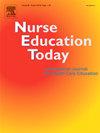开发和评估针对护士的间隔式电子学习干预措施,以加强导尿管管理--与研究最终用户合作开展的共同设计研究
IF 3.6
2区 医学
Q1 EDUCATION, SCIENTIFIC DISCIPLINES
引用次数: 0
摘要
背景护士在支持患者自我管理留置导尿管和预防可避免的住院治疗方面发挥着至关重要的作用。本研究旨在探讨共同设计的教育方法的有效性,该方法旨在提高护士为留置导尿管患者提供最佳护理的能力。环境来自澳大利亚新南威尔士州一个地区的护士(n = 127)参与了这项研究。这些护士在不同的社区环境中提供医疗服务。该研究获得了当地卫生区的伦理批准(HREC/2019/ETH12575),并在ANZCTR(ACTRN12621000683831)上注册。方法采用混合方法,收集基线和干预后的数据。定量数据采用描述性统计、正态性检验和双变量分析(Wilcoxon Signed Ranks test)进行分析,以确定变量之间的差异。定性数据采用定向内容分析法进行分析,对特定现象的出现进行分类。此外,在八个问题中,有七个问题的知识得分在干预后的提高幅度分别为:(1)、(2)和(3):经济支持6.1%;性生活:7.9%;导尿:11.3 %.定性研究结果证实,电子学习模块有效地改变了参与者的临床实践,从而改善了患者的治疗效果。将理论模型和情境方法融入干预措施的实施中,提高了相关性、个性化和参与度,促进了改变当前实践所需的行为改变。本文章由计算机程序翻译,如有差异,请以英文原文为准。
Development and evaluation of a spaced eLearning intervention for nurses in enhancing urinary catheter management - A co-design study in partnership with research end-users
Background
Nurses play a critical role in supporting patients in self-managing their indwelling urinary catheters and preventing avoidable hospital presentations. This study aimed to explore the effectiveness of a co-designed educational approach developed to enhance nurses' ability to provide optimal care for patients with catheters.
Aim
The primary aim of this study was to enhance nurses' knowledge and skills in urinary catheterisation, care, and management. The secondary aim was to transform their current catheter management practices to improve patient outcomes.
Setting
Nurses (n = 127) from one New South Wales, Australia region participated in the study. These nurses provided healthcare across various community settings. Ethics approval was received from the Local Health District (HREC/2019/ETH12575) and the study was registered in ANZCTR (ACTRN12621000683831).
Methods
A mixed-methods approach was used, collecting data at baseline and after the intervention. Quantitative data were analysed using descriptive statistics, tests for normality, and bivariate analysis with the Wilcoxon Signed Ranks test to identify differences between variables. Qualitative data were analysed using a directed content analysis approach to categorise occurrences of specific phenomena.
Results
The composite mean knowledge score increased from 65.03 to 84.30 following the intervention (p < 0.001). In addition, the magnitude of knowledge score improvement in seven out of eight questions following the intervention were: Financial support: 1.1 %; Bladder spasm/urine leakage: 3.3 %; Blockage: 3.5 %; Catheter-Associated Urinary Tract Infection (CAUTI): 4.4 %; Self-management: 6.1 %; Sexuality: 7.9 %; and Urinary catheterisation: 11.3 %. Qualitative findings confirmed that the eLearning module was effective in transforming participants' clinical practice, towards improving patient outcomes.
Conclusions
The co-designed eLearning module effectively addressed the learning needs of nurses, enhancing their knowledge and skills in urinary catheter management. Incorporating a theoretical model and contextual approach in the intervention delivery increased relevance, personalisation, and engagement, facilitating the behaviour change required to transform current practices.
求助全文
通过发布文献求助,成功后即可免费获取论文全文。
去求助
来源期刊

Nurse Education Today
医学-护理
CiteScore
6.90
自引率
12.80%
发文量
349
审稿时长
58 days
期刊介绍:
Nurse Education Today is the leading international journal providing a forum for the publication of high quality original research, review and debate in the discussion of nursing, midwifery and interprofessional health care education, publishing papers which contribute to the advancement of educational theory and pedagogy that support the evidence-based practice for educationalists worldwide. The journal stimulates and values critical scholarly debate on issues that have strategic relevance for leaders of health care education.
The journal publishes the highest quality scholarly contributions reflecting the diversity of people, health and education systems worldwide, by publishing research that employs rigorous methodology as well as by publishing papers that highlight the theoretical underpinnings of education and systems globally. The journal will publish papers that show depth, rigour, originality and high standards of presentation, in particular, work that is original, analytical and constructively critical of both previous work and current initiatives.
Authors are invited to submit original research, systematic and scholarly reviews, and critical papers which will stimulate debate on research, policy, theory or philosophy of nursing and related health care education, and which will meet and develop the journal''s high academic and ethical standards.
 求助内容:
求助内容: 应助结果提醒方式:
应助结果提醒方式:


